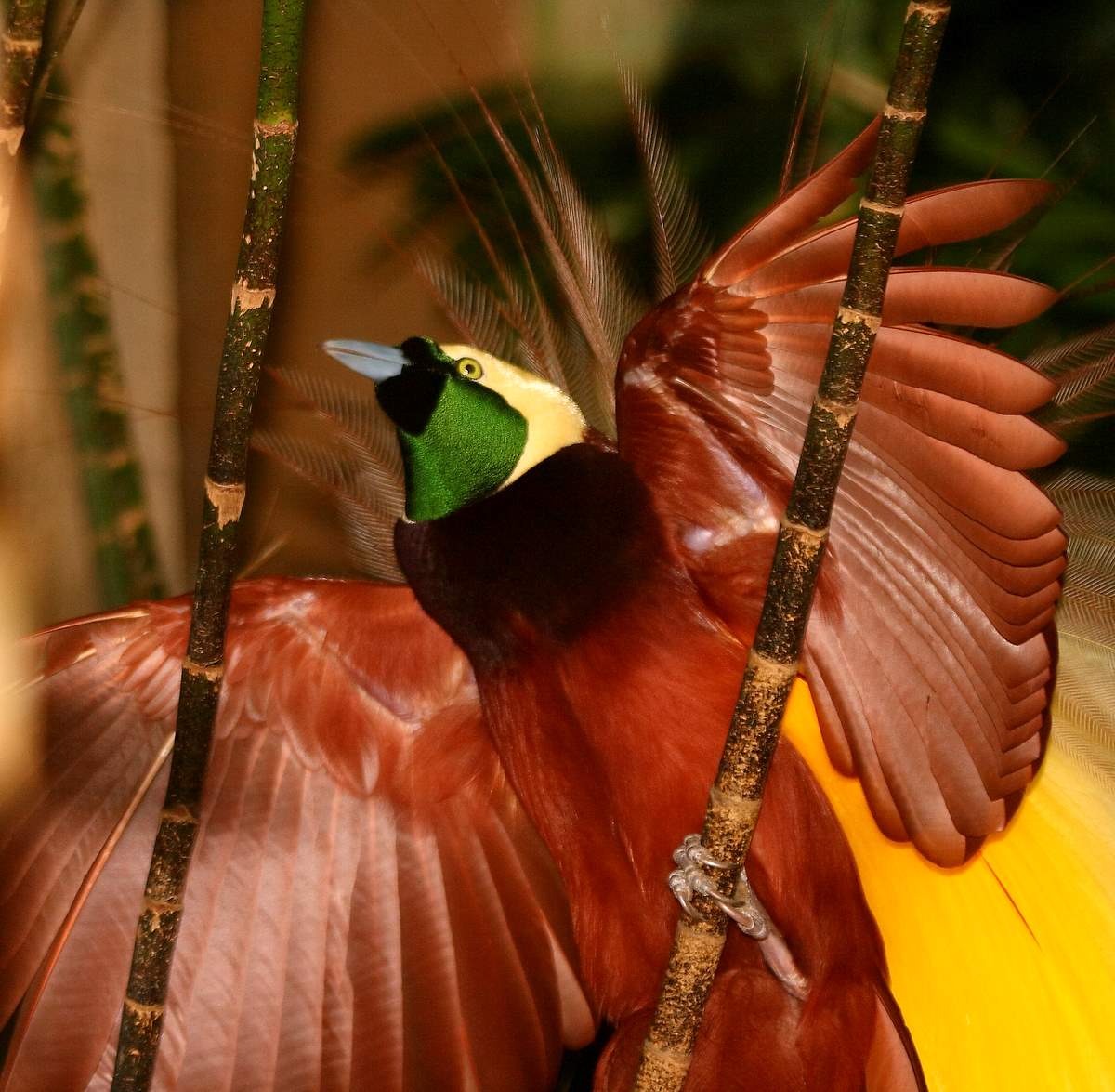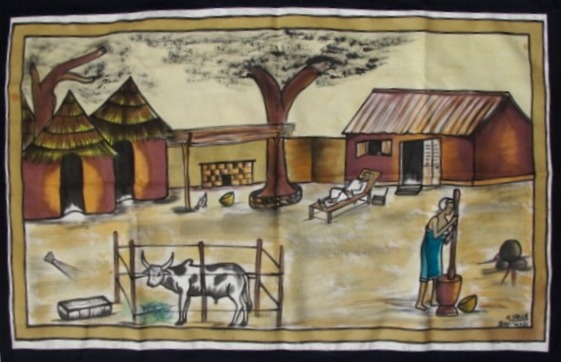BBC 100件藏品中的世界史006:Bird-shaped Pestle巴布亚新几内亚鸟形杵
006:Episode 6 - Bird-shaped pestle
第六集——巴布亚新几内亚鸟形杵
Bird-shaped pestle (made 4 - 8,000 years ago). Stone, found in Papua New Guinea
鸟形杵,石制,距今约4000至8000年,巴布亚新几内亚。
Lunch here at the British Museum staff canteen has always been a pretty international affair. It's not just the scholars and the curators who come from all round the world; it's also of course the food.
在大英博物馆职工餐厅里吃午餐,堪称是一件相当国际化的事情。一则博物馆里的学者与管理员都是来自全球世界,二则当然大家所吃的食物也是。
As today is one of my healthy days, I'm at the salad bar, looking in among the greens at a fairly standard run of potato salad, rice, sweetcorn and kidney beans. What I find interesting about these vegetables is not just that they come originally from all over the world, but that none of them would exist in the form they do today if the plants they come from hadn't been carefully chosen, cherished and modified in a long process that began about ten thousand years ago with some intrepid and ingenious Ice Age cooks.
今天恰好是我的“健康日”之一,所以我站在沙拉吧前边,在一大堆形形式式的蔬菜前面左看看,右瞧瞧。菜式挺标准的,有土豆沙拉、米饭、甜主米、腰豆等等。让我对这些蔬菜颇感兴趣的倒不是它们源产地本来是遍及世界各地,而是假如不是当年经过一代又一代的人类精心选择,仔细培育,品种改良,这些植物也不可能会长得现代这样子了。而那漫长的过程,早在距今约一万年前,就由冰河时代那些勇敢而天才的厨师们开始了。
'Everyone did these things, and the families existed as families because you did it not for yourself but for the family.' (Madhur Jaffrey)
“大家都在做这些日常琐事,而家庭之所以存在恰恰是因为你不仅仅是为了自己,还为了家庭。”梅赫尔·杰弗瑞说道。
'We need some new evolutionary tricks in order to spread out into increasingly hostile environments.' (Martin Jones)
“为了能在日趋恶劣的环境里开枝散叶、生息繁衍,我们需要拥有更新、更加进化的技能。”马丁·琼斯说道。
In previous programmes, we have looked at how our ancestors moved around the world; in this week's programmes I'm going to be focussing on what happened when they settled down. This is a week full of ancient animals, powerful gods, dangerous weather, good sex and even better food.
在之前的节目里,我们观察我们的祖先们是如何全世界迁徙;在本周的节目里,我将聚集于当人类开始定居生活后所产生的变化。本周节目将充满各种古老动物、强大神灵、恶劣气候、美好性爱与美食佳肴。

Around 11,000 years ago, the world underwent a violent and rapid period of climate change, leading to the end of the last Ice Age.
大约一万年前,这世界经历了剧烈而快速的气候巨变期,导致了最后一次冰河时代的终结。
Temperatures increased by as much as seven degrees centigrade in a hundred years, and sea levels rose by over 300 feet (or 100 metres). Ice turned to water and snow gave way to grass, and the result was slow but profound changes in the way that humans lived. Over the course of this week, I will be covering about seven thousand years of human history when, as the Ice Age ended, people in many different parts of the world began to breed animals, grow plants and eat differently.
百年之内气温上升高达七摄氏度,海平面上升超过三百英尺,即一百米。冰川融化成水流,积雪让位给绿草。这过程是缓慢的,然后给人类生活方式带来的改变却是深远的。在本周的各期目里,我将涵盖人类历史之河中将近七千年的历史;当冰河时代结束,全球各地的人类开始了繁殖牲畜、种植庄稼,而且饮食方式也大大改观了。
Ten thousand years ago, the sound of daily life began to change across the world, as new rhythms of grinding and pounding prepared the new foods that were going to change our diets and our landscapes. For a long time, our ancestors had used fire to roast meat but, in the sense that we would use the word today, they were now 'cooking'.
一万年前,日常生活中与人类朝夕相伴的声音在全世界范围内都改变了,随着人类开始采用新方式来准备新食物,真可谓是日日砧杵动,家家捣捶声了,而我们的饮食与周遭环境也将迎来新改观。漫漫岁月中,曾几何时,我们祖先们已经学会了取火烧肉。也许某种意义上,按我们现代人的说法,他们现在会进行“烹饪”了。
There's an enormous range of objects in the British Museum that we could have chosen to illustrate this particular moment in human history, when people literally start putting down roots and cultivating plants that will feed them all year round.
于是人类真真正正地开始落地生根,培育起庄稼,这些植物将能够常年到头为他们提供食物;而在大英博物馆数量庞大的藏品中,能被挑选出来描绘这特殊历史时刻的物品,简直是随手可得。
The beginning of this sort of farming is a process that seems to have happened in many different places at more or less the same time, and we've recently discovered that one of these places was Papua New Guinea, that huge island just to the north of Australia, where this bird-shaped stone pestle comes from.
这种耕作方式的开始,几乎是一个在全球范围内同步发生的过程;我们最近发现的这些地方之一便是巴布亚新几内亚,那座澳大利亚以北的巨大岛屿,我们这鸟形杵就是从那里出土的。
We think it's about eight thousand years old, but a pestle then would have been used exactly as it is now - to grind food in a mortar and break it down, so that you can make it edible.
我们估计它大概有八千年的历史,一根舂杵,纵使历练悠悠岁月,不变的是它当初的使用功能;它仍然可以胜任研磨研钵里食物的工作,供人们食用。
It's a big pestle, it stands just over a foot tall (about 35 cm), and the business end is a stone bulb, about the size of a cricket ball, and you can feel that it's been much used. Above the bulb, the shaft is very easy to grasp and the upper part of the handle, or the shaft, has been shaped in a way that's got nothing to do with making food at all - it looks like a slender, elongated bird with wings outstretched and a long neck dipping forward; it looks a bit like Concorde.
这根舂杵满大的,直立起来大概有一英尺高,约三十五厘米长,它的下头是一个大石球,板球大小,看得出被常年使用过。石球上端的长柄很好抓取,这长柄或杆子的上端部分,却被塑造成一种与舂捣谷物无关的造型,它看上去像一只纤细而被拉长的鸟,张开双翅,长长的脖子优雅地弯向前,看上去真有点像只协和式飞机。
We're very familiar now with the idea that making food unites us, either as a family or a society, and we all know how much family memory and emotion is bound up in the pots and pans and wooden spoons of childhood. These sorts of associations seem to date from around ten thousand years ago; from the very beginning of cooking implements, roughly the period of our pestle. The chef Madhur Jaffrey is still very attached to her pestle, which her mother gave her when she left India, and she came to look at ours:
现在众所周知,是食物将我们团结起来,构成家庭或者社会,而且大家都有多么亲切的关于家的记忆与情感,那岁月中锅碗瓢盆与木汤匙的童年。这样子的情感纽带似乎早在一万年前就开始形成了,在烹饪厨具开始被运用起来的最早期,大概与我们这根舂杵是同一时代的。厨师梅赫尔·杰弗瑞仍旧相当依恋她的舂杵,那是当年她离开印度时,她母亲送给她的。当她观察我们的这把舂杵时,说道
'I just thought it was beautiful to look at and had a well-honed, worn look, and a patina that made me feel that it was used - and used again and again. It is a fundamental act both of cooking and of living, and living with a family and passing on, at least in India.
“我只觉得它看起来很美丽,打磨精致,有点磨损,古色古香,让我觉得这是一把曾经被反复使用过的舂杵。至少在印度,使用它,会是一种烹饪与生活中最基本的行为,一种代代相代的家庭生活。”
'When I left India, which was a long long time ago, my mother gave me certain utensils to take with me, and they were all heavy, I remember that. There was a wok, a grinding stone, and a huge mortar and pestle, so those are what I left with, and I have all of them, and I use my mortar and pestle to this day.'
“很多很多年前,当我离开印度时,我母亲送给我一些厨具带在身上,我记得它们可真是沉甸甸的呵。有个锅、研磨石,还有研钵跟舂杵。这些就是我离开家时的所有,现在我还保留着,这研钵跟舂杵还在天天使用。”
Other stone pestles and mortars have also been found in New Guinea, and what they show is that there were farmers growing crops in the tropical forests and grasslands here in ancient times, around ten thousand years ago.
其他石杵与研钵也在新几内亚出土,它们显示了一万年前左右,在这些热带森森与草原上,已经出现在人类从事农业劳作、养育庄稼的身影。
This relatively recent discovery has upset the conventional view that farming began in the Middle East, in what's called the Fertile Crescent, and from there spread across the world.
相当近期的考古发现挑战了传统观点,认为农业起源于中东一带所谓“新月沃土”的地区,随后向世界各地蔓延。
We now know that in fact this particular bit of the history of humanity happened simultaneously in many different places.
我们现在知道,其实在这段人类历史上的特定时期,这种变化在全球范围内是同步产生的。
Clearly a lot of us became farmers at the same time, and wherever people were farming, they began to concentrate on a small number of plants, selectively harvesting these from the wild, planting and tending them.
显然我们当中相当多的人开始在这时期转换成农民的角色,而且不管人类在何地耕作,他们总是开始把注意力集中到若干类的植物种类上,有选择性地从野外采集回来,种植起来,用心照料。
In the Middle East, they chose particular grasses - early forms of wheat; in China, wild dry rice; in Africa, sorghum - a grain that looks a bit like grass; and in Papua New Guinea, the starchy tuber, taro.
在中东,人类选择了一种特殊的草本植物,以最早期的小麦,在中国的是野生旱稻,在非洲是一种看上去有点像野草的高梁,在巴布亚新几内亚, 是芋头这种淀粉块茎。
For me, the most surprising thing about these new plants is that in their natural state you very often can't eat them at all, or at least they taste pretty filthy if you do. Why would you choose to grow food that you can eat only once it's been soaked or boiled or ground to make it edible at all?
对我而言,最值得惊叹的莫过于,这些新植物在自然状态下其实是不可食用的,至少很难下咽。为何人类会选择种植这种得经过像浸泡、煮沸或研磨后才可以食用的食物呢?
Martin Jones, Professor of Archaeological Science at Cambridge University, sees this alchemy of food as an essential part of human evolution:
剑桥大学考古学教授马丁·琼斯把加工提炼食物看成是人类进化过程中的重要组成部分:
'As the human species expanded across the globe, we had to have a competitive edge over other animals going for the easy food.
“随着人类在全球范围内扩张,我们避免不了在那此唾手可得的食物方面与其他动物进行激烈竞争。
So we went for the difficult food, we went for things like the small hard grass seeds we call cereals, that are indigestible if eaten raw and may even be poisonous, and we have to pulp them up and turn them into things like bread and dough. And we went into the poisonous giant tubers, like the yam and the taro, which also had to be leeched, ground up and cooked before we could eat them. And that was our competitive advantage - other animals that didn't have the big brain couldn't think several steps ahead to do that.'
因此我们另开蹊径,去寻找那些要获取的话,相当困难的食物。我们寻找到了那种被我们称之为谷物的草籽,又小又硬,生吃的话,肯定消化不了,甚至可以有毒性;于是我们学会了把它们浸泡成浆,再做成类似面包或面团之类的东西。我们也寻找到了那些带有毒性的、个头颇大的块茎,像山药、芋头,这些在食用之前得经过榨取、提炼和烹饪。这就是我们人类的竞争优势,其他动物可没有具备像我们这么发达的大脑,能够有预见性,超前跳跃式的进行思考。”
So it takes brains to get to cookery. We don't know what gender the cooks were who used our pestle to grind taro in New Guinea, but we do know from archaeological research in the Middle East that cookery there was primarily a woman's activity.
所以烹饪也是需要动脑筋的。我们无法知道这根使用舂杵的厨师性别是男是女,但中东地区的考古成果显示通常烹饪是女性主导的。
From examining burial sites of this period, scientists have discovered that the hips, ankles and knees of mature women are generally severely worn - the grinding of wheat then would have been done kneeling down, rocking back and forth to crush the kernels between two heavy stones. 通过研究这一时期的墓葬遗址,科学家们发现成年女性的臀部、脚踝与膝盖部位严重磨损——那时研磨小麦,通常需要双膝下跪、利用前后两块沉重石头来回滚动,反复研磨,直到把谷物碾碎。这种活动会导致关节炎,肯定是相当艰苦的。
This arthritis-inducing activity must have been very tough, but the women of the Middle East and the new cooks everywhere were cultivating a small range of nourishing basic foods that could sustain much larger groups of people than had been possible before. Most of these new foods were pretty bland, but the pestle and mortar can also play a key part here in making them more interesting. Madhur Jaffrey again:
不过中东这些妇女与世界其他地区的新厨师们正在培育出一种最基本的滋补食品,品种虽少,却可以养活史无前例庞大数目的人口。这种新型食品大部分嚼之无味,但是这研钵与舂杵却很关键使一切变得更加丰富有趣。梅赫尔·杰弗瑞再次说道。
'If you take mustard seeds, which were known in ancient times, if you leave them whole they have one taste, but if you crush them, they're like Jekyll and Hyde; they become pungent and bitter, so you change the very nature of a seasoning by crushing it.'
“比如芥菜籽吧,远古时代的人类认识它了。如果整颗的话,尝起来是一种味道;而如果碾碎了,就像是‘变身博士’了,它的味道就变得辛辣、苦涩。因此你可以通过碾磨来从本质上改变一种调料。”
And Martin Jones believes that in due course, this early farming changed the whole pattern of our society:
马丁·琼斯认为,这种早期农耕形式最终顺理成章地改变了我们的社会模式:
'We specialise in those smaller number of foods - not stopping the others - but emphasising a smaller number of foods, and that's how agriculture emerges, and it allows people to interact in different ways, to share food in different ways and to make contact with each other in different ways.'
“现在我们专注于品种较少的食物,没有停止食用其他种类,但却更注重于若干种类的食物;于是产生了农业,促使人类互动的方式多样化起来,来分享食物,来与彼此交流沟通。”

These new crops helped create new kinds of communities because, if you were lucky with the weather, they could produce surpluses which could then be stored, exchanged or simply consumed in a great feast. Our pestle's long, thin elegant body looks far too delicate to have been able to withstand the vigorous daily pummelling of taro, so we should perhaps think of it more as being used to prepare special meals; meals where people gathered, as we might do today, to trade, to dance, or to celebrate key moments in life. Sharing food is one of the most basic ways of binding people together.
这些新兴农作物有助于人类社区的建立,因为假如你运气够好,遇上风调雨顺的气候,收成好了,就可以囤存余粮,就可以彼此交换,或者直接大家聚一起大快朵颐,饱餐一顿。我们这根舂杵纤长优雅的身形,看上去似乎承受不了常日生活里大力碾磨芋头那种粗活苦活,也许我们应该把它看作来用准备特殊膳食的,一场人们欢聚一堂的盛宴,就像我们今天也可能做的一样。盛宴上大家进行物物交换,欢歌乐舞,庆祝生命中的关键时刻。分享食物是巩固人与人之间纽带的一种最基本方法之一。
Looking at the food in the British Museum canteen, so much of it flown across the world, I'm struck by the fact that while we all travel more and more freely, we depend on food grown by people who cannot move, who must stay on the same piece of land.
在大英博物馆职工餐厅里,环顾四周,这么多的食物都是从世界其它地方空运过来的。让我十分感概的是在我们拥有越多自由四处旅行的今天,我们仍旧依赖于那些农作物,种植它们的人们相当于被固定在那片土地上,无法自由旅行。
We're all increasingly aware of how vulnerable this makes farmers across the world to any change in climate, and this dependence on regular predictable weather led the farmers of ten thousand years ago to identify gods of food and climate, who needed constant placation and prayer in order to ensure the cycle of nature and safe, good harvests. Nowadays, most people look to governments, and to campaigners like Sir Bob Geldof:
这让我们越来越意识到在各种气候变化面前,全世界的农民与农业是多么的脆弱。其实早在一万年前,农民已经学会了依赖于定期预测气候变化,也因此导致他们开始定义出掌管食物与气候的神灵,这些神灵需要人类不断的祭拜与祈祷,才会保佑人们风调雨顺、谷物丰收。如今,大多数人把希望寄托到各国政府上,或者像鲍勃·格洋多夫爵士一样的活动家:
'The whole psychology of food, where it places us, is I think more important than almost any other aspect of our lives. Essentially, the necessity to work comes out of the necessity to eat. So, this central idea of food is the fundamental in all human existence.
“就心理角度而言,我觉得食物比我们生活中其他方方面面几乎都要更加重要。本质上讲,劳作的必要性来源于吃的必要性。所以食物的中心思想便是所有人类生存的根本。
It's clear that no animal can exist without being able to eat, but right now, at the beginning of the 21st century, it is clearly in the top three of priorities for the global powers to address. Upon their success or not will depend the future of huge sections of the world population. There simply isn't enough food for the world at the moment. There are several factors, but the predominant one is climate change.'
很显然,没有任何动物能不依靠吃而存生。在二十一世纪开端的今天,它无疑位居全球各力量必须最优先解决的三大问题之首。其成功与否将取决于未来世界人口的绝大部分。目前而言世界上根本没有足够的食物。其中因素有几个,但最主要的就是气候变化。
So a change in climate, like the one that brought us agriculture in the first place, is now threatening our global survival. Just after the Ice Age, the growing population that the new foods allowed was of course not a problem but a positive advantage. The first settled societies increased quickly in numbers and, as long as the weather allowed, they developed new, stable communities.
因此当初气候变化迎来了我们农业的诞生,而今这种气候变化却已经威胁到我们全球人类生存。当初冰河时代后,新兴粮食的到来引起的人口增长,并非是个问题,而是一种优势。最早的人类定居群体在人口数量上增长迅速,而且在气候允许的情况下,发展出更多新兴、稳定的人类群体。
Tomorrow I'll be focussing on the fertility not of the land, but of the people farming it. I'll be looking at a stone sculpture that's the first representation, anywhere, of a couple making love.
明天我的侧重点将不是土地的肥沃力,而是在土地上耕作的人类的生育能力。我将会介绍一件石头雕塑品,全世界史上最早的男女配偶间性爱活动的象征品




















